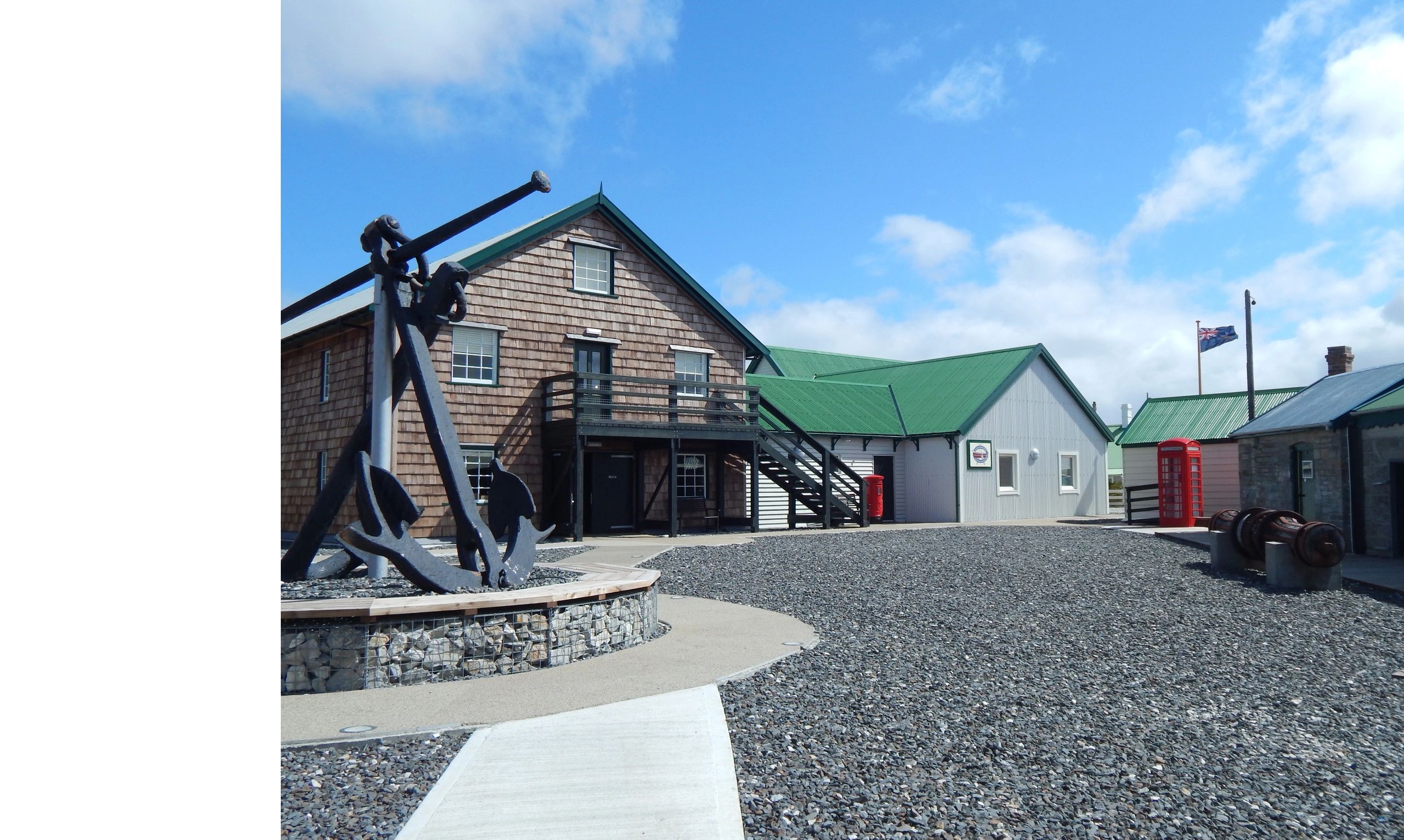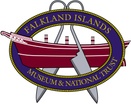
The Historic Dockyard Museum
This Museum is the only place you will experience the full flavour and essence of the Falkland Islands.
Through the varied galleries and artefacts explore the heritage and history of the Islanders, learn of the explorers, the invaders and liberators, the animals, rocks and plants, and the sea all around us.
Our Galleries
Social History
Much of the Museum is dedicated to the social history of the Falklands and it is the every-day nature of many of these items that makes the Museum so absorbing.
The Falkland Islands have a relatively “young” society so the majority of items in the collection do not date back further than the mid-to-late 1800s. It is however, a full and varied collection thanks largely to the practical nature of Islanders - over the generations a long-standing habit developed whereby nothing was thrown away (after all, you never know when it might come in handy…)
Extended lines of communication meant that obtaining replacements was often very expensive and time-consuming so little was ever wasted, and obsolete or unused items were squirreled away for possible future use. As a result cupboards, lofts and sheds are still often found to be full of fascinating items which, thanks to the continuing generosity of Islanders, often make their way to the Museum.
At the Museum you will find display cabinets overflowing with trinkets and treasures.
Camp
Much of the history of the Falkland Islands revolved around the lives and lifestyles of the rural community - the farmers and workers who lived in the Camp (the name given to everywhere outside of Stanley).
Although there are still many people in the Islands who live and work in Camp, much has changed over the years. There has been many developments in agriculture and the farming structure of the Islands. The way campers communicate without the outside world has changed dramatically. As has the way they receive medical and dental treatment - the days of the traveling dentist's chair have long gone!
However there are also many aspects to farming life that have stayed relatively the same. People still live of the land, children still receive telephone lessons and the traditions of Sports Weeks and two-nighters are still going strong.
Despite there being fewer and fewer people living out at Camp nowadays, this way of life is still as important to the Islands now as it was in the early days.
Costumes
Until relatively recently clothing in the Falkland Islands would generally have been chosen for its practicality, but the fashion-conscious generally favoured the trends that were popular in Great Britain, albeit somewhat belatedly.
With months-old magazines and “mail-order” catalogues offering inspiration, ladies in the 1800s could be dressing in fashions already a year old by the time patterns and materials were selected, sent for, and made up. These pieces would then be adapted or passed on to other family members - although our costume collection is quite small, many of the items have clearly had pieces added or removed to give new life to an old garment, or been taken in for a new wearer.
Natural History
Our Natural History Collection is varied and contains a range of biological and geological material. We have taxidermy displays, skins, whole skeletons, bones, fossils and rocks.
Our collection includes examples of rare fossils and bones collected right here in the Islands, like for example, the now extinct Warrah and Coleen's 'starfish'.
The area is dominated by a 7 meter diorama which features various birds that include a King Penguin, Rockhopper, Gentoo, Black Browed Albatross as well as the majestic and impressive Royal Albatross, plus others.
Maritime
The Falkland Islands have a rich maritime heritage, largely because of our location close to one of the world’s great trading routes.
Cape Horn provided an essential route between the Pacific and Atlantic oceans prior to the building of the Panama Canal (opened in 1914) and the Falklands were well-placed to offer shelter, supplies and repairs to passing ships.
Falkland Island waters were notoriously treacherous to navigate before the Royal Navy completed soundings, and this is paid testimony to by the 120 or so wrecks that are known to lie off the rocky coasts; there are almost certainly many more ships lost to the sea without record.
Stanley Harbour itself was something of a ship graveyard – until the 1980s more than a dozen vessels of various sizes lay hulked or abandoned along the shoreline. Sadly, today less than half that number can be seen, and in the most part the remains are little more than skeletal – truly relics of a bygone age.
The hulks of 19th century ships, such as the Charles Cooper and the Jhelum, that had been striking features of the harbour for generations have been lost to us in just the last few years. The few that remain in reasonably intact will not survive indefinitely.
1982
It is a frequent misconception that there is nothing more to Falklands history than the war in 1982. However, although it was undoubtedly one of the most significant events in our history and a watershed moment, it was in fact a relatively brief period and this is reflected in the size of the 1982 Gallery.
The Historic Dockyard Museum is at its heart a social history museum, so we felt it was important to present the events from the point of view of the local population. Our 13 minute video compilation tells the story of the Argentine invasion and occupation, and the subsequent liberation by British forces, through the eyes of Islanders who were children at the time – giving a new and moving insight into events which have been related many times from many other perspectives.
The 1982 Gallery is largely audio-visual in content and so includes very little in the way of artefacts, but it is our intention to create a new space in the near future in which these items can be displayed and more detail of the battles and the military campaign, as well as the very significant contributions made by Islanders, can be explored.
Antarctic Heritage
The strong bonds between the Falklands and Britain’s Antarctic operation run deep. Over the decades, hundreds of Antarctic researchers have spent time here on their journeys to or from the frozen continent and Islanders themselves were part of Operation Tabarin, their skills and hardiness paved the way for the many local men who followed in their footsteps.
A great many Falkland Islanders have served their time in Antarctica, whether joining up as Falkland Islands Dependencies Survey (FIDS - the fore-runner to the British Antarctic Survey) or crewing the research ships, and others have given valuable logistic support from Stanley. Working on the boats was seen as good work for a young man with a taste for adventure and at one stage the entire crew of the RRS John Biscoe - bar the captain - were Islanders.
The Reclus Hut
The Antarctic Gallery in the Diamond Jubilee Building was especially designed to hold the Reclus Hut. The building and nearly all of its contents are original and it celebrates an element of Polar exploration which is all too often overlooked, although it was in truth an extension of the Heroic Era.
Prefabricated in Stanley in 1956, the refuge was erected at Cape Reclus on the Antarctic Peninsula and used by the Falkland Islands Dependencies Survey (FIDS).
Following a conservation survey of the remaining FIDS stations in the 1990s, the UK Antarctic Heritage Trust recommended that the Reclus Hut should be offered to the Falklands Museum. Shortly afterwards it was carefully dismantled and returned to Stanley where it was rebuilt in the Museum grounds.
The Hut contains many of its original contents as well as contemporary equipment provided by BAS and tells the fascinating story of a team of FIDS who over-wintered there in 1957.
The site where the hut stood was later named Portal Point in recognition of the location’s role as a gateway from the west coast and the east coast of the Antarctic Peninsula.
The Tim Simpson Gallery
The Tim Simpson Gallery is a space dedicated to the memory of dear museum friend and trustee, Mirabel 'Tim' Simpson.
This gallery changes
Outside Buildings
The Smithy
The Wash House
The Wash House

This 1840s building displays not just the forges and tools needed by the blacksmith but also those used by cobblers, carpenters, farm-workers and horsemen. Liberation, our friendly farm horse, shows off traditional and hand-made tack selected from our very well-equipped Gearshed.
The Wash House
The Wash House
The Wash House

Hard working Islanders always encountered mud and muck. To keep us all presentable for Church on Sunday we had to clean and press our best even before we had electricity.
The Print Shop
R/T Station & Telephone Exchange
R/T Station & Telephone Exchange

This display stands on the very spot where Stanley's first printing press was established in the 1800s. The equipment inside has churned out everything from newspapers and wedding invitations to proclamations of war.
R/T Station & Telephone Exchange
R/T Station & Telephone Exchange
R/T Station & Telephone Exchange

Keeping in touch has always been vital to an isolated community like ours and the importance of radio and telecommunications is reflected in this building. Discover why even the most personal medical details were shared Island wide in the days of the R/T Station and how our Telephone Exchange operators kept connecting calls even as bullets flew.
Falkland Islands Museum & National Trust
Historic Dockyard Museum - Stanley - Falkland Islands
This website uses cookies.
We use cookies to analyze website traffic and optimize your website experience. By accepting our use of cookies, your data will be aggregated with all other user data. Privacy Policy
